India took a leading step in maritime development by enabling Prime Minister Narendra Modi to inaugurate the Vizhinjam International Seaport in Kerala which establishes vital trade connections and logistics sovereignty for the nation.
The port holds its position near critical international seaway routes in the Arabian Sea at ten nautical miles distance while its development took shape through public-private cooperation at Rs 8,900 crore. Vizhinjam International Seaport receives project management from Adani Ports and Special Economic Zone Ltd (APSEZ) through a partnership with Kerala Government together with central government support.
The Vizhinjam port operates as an essential gateway solution for India’s maritime framework due to its potential to receive “mother vessels” containing 20,000 containers. Almost seventy percent of India’s transshipment cargo processing depended on three overseas ports: Colombo, Singapore, and Jebel Ali until this moment. The dependence on overseas ports resulted in dual expenses for Indian business operations through additional container charges of $80 to $100 and annual financial losses ranging between $200 million and $220 million.
Vizhinjam’s Natural Depth Cuts Costs, Boosts Efficiency
A key advantage of the port lies in its geography. The seabed depth reaches 18–20 meters within a kilometer of the shore, enabling direct berthing for the world’s largest ships without the need for dredging—a costly and ecologically disruptive process that most Indian ports require. Moreover, the coastline around Vizhinjam is uniquely stable, with very low sand movement, meaning ongoing maintenance costs will be significantly lower.
In terms of ownership, the Kerala government holds a 61.5% majority stake, Adani Ports controls 28.9%, and the Union government owns 9.6%. This partnership structure aims to combine private sector efficiency with public sector oversight.
Earlier this year, the port handled MSC Türkiye, one of the largest container vessels in the world with a capacity of more than 24,000 TEUs (twenty-foot equivalent units). It was the first Indian port ever to dock a ship of that size, demonstrating Vizhinjam’s readiness for large-scale operations.
Vizhinjam Equips to Hold 1 Million Containers
Currently equipped to handle 1 million containers per annum, the port’s infrastructure is planned to expand across two more development phases, adding capacity for another 6.4 million TEUs. Once fully operational, this facility is expected to significantly reduce India’s dependence on foreign ports, lower freight costs, and boost overall shipping efficiency.
The on-ground infrastructure further strengthens its viability as a logistics hub. The port is located just 2 km from a national highway, 12 km from a major railway line, and 15 km from the Trivandrum International Airport—ensuring seamless multi-modal cargo movement across the country.
The Prime Minister’s Office highlighted that the project is part of the broader “Viksit Bharat” vision, which emphasizes infrastructure modernization to position India as a self-reliant and globally competitive economy. Vizhinjam is seen as a core pillar of India’s maritime development plan and a model for future port projects.
India to Construct Other Deepwater Ports
In addition to Vizhinjam, India is moving ahead with the construction of other deepwater ports to support growing trade demands. Work began on the Vadhvan port in Maharashtra’s Palghar district in August 2024, and another major transshipment hub is proposed on Great Nicobar Island, currently awaiting regulatory approvals.
India has 13 major ports and over 200 non-major ports. While existing container ports like Mundra and Jawaharlal Nehru Port handle over 7 million TEUs annually, Vizhinjam is set apart as India’s only dedicated deepwater transshipment terminal with direct access to global shipping routes.
By cutting reliance on foreign transshipment points and offering cost-effective, large-scale container handling, Vizhinjam is expected to anchor India’s emergence as a critical player in global maritime trade.


